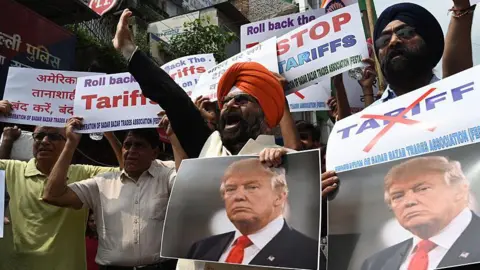The Indian pot belly, long embraced as a snazzy symbol of comfort and success, is facing a startling transformation into a sign of impending health disaster. What was once associated with indulgence and seniority has morphed into a key player in India's escalating obesity crisis.
Historically, this belly type served as a cultural marker, suggesting wealth or prosperity. However, current statistics reveal a troubling reality—India reported the second-highest number of overweight adults in 2021 at a staggering 180 million, only trailing behind China. A recent study published in The Lancet projects that this figure may swell to 450 million by 2050, nearly a third of the anticipated population. The global implications are just as concerning, with predictions that more than half of all adults and a third of children worldwide could experience similar weight-related challenges.
Central to this crisis is abdominal obesity, or the accumulation of excess fat around the waist. Experts assert that this form of obesity extends beyond mere aesthetics or societal perception—it harbors serious health implications. Historical research has linked belly fat to chronic conditions, including Type 2 diabetes and heart disease.
Data from the National Family Health Survey (NFHS-5) reveals that about 40% of women and 12% of men in India suffer from abdominal obesity. Defined by a waist circumference exceeding 90 cm (35 inches) for men and 80 cm (31 inches) for women, these measures indicate a growing trend amongst India's urban population, characterized by alarming waist measurements that can signal significant health risks.
The growing prevalence of belly fat leads to a host of complications, primarily due to insulin resistance, where the body's response to the hormone responsible for blood sugar regulation deteriorates. Studies demonstrate that South Asians, including Indians, tend to store fat differently than their Caucasian counterparts, accumulating fat in less efficient patterns. Disturbingly, excessive fat infiltrates vital organs over time, further elevating the risk of diabetes and heart diseases.
Despite ongoing research, scientists are still unraveling the genetic and environmental dynamics that dictate fat distribution. An intriguing evolutionary theory posits that historical famines shaped the human body to store energy efficiently, leading to the excesses we witness today.
In response to this public health challenge, the Indian Obesity Commission has revised obesity criteria for Asian Indians, moving beyond traditional BMI metrics to focus on specific fat distribution patterns and associated health impacts. This refined classification system guides individualized treatment plans—ranging from simple lifestyle alterations to intensive medical interventions, depending on the individual's level of abdominal obesity and related health risks.
Experts identify lifestyle changes as the primary driver of rising abdominal fat in India. Increased consumption of junk food, takeaway meals, and rapid cooking options have all taken a toll. Studies indicate that from 2009 to 2019, India experienced a notable rise in per capita sales of ultra-processed foods.
To confront this looming health crisis, experts recommend more rigorous lifestyle adjustments tailored to South Asian individuals—around 250-300 minutes of exercise weekly, compared to the 150 minutes recommended for their European counterparts. This increase reflects the unique metabolic challenges faced by the population.
In summary, the pot belly is no longer just a lighthearted jab—it has emerged as a ticking health time bomb that could impact millions in India if significant changes aren't implemented. The message is clear; without immediate action and lifestyle renovations, the future of health and well-being in India hangs in the balance.






















